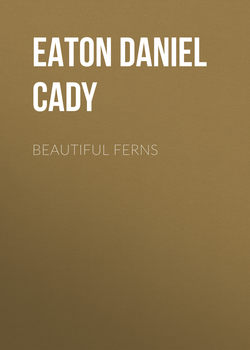Читать книгу Beautiful Ferns - Eaton Daniel Cady - Страница 3
PHEGOPTERIS ALPESTRIS, Mettenius.
Alpine Beech-Fern
ОглавлениеPhegopteris alpestris: – Root-stock short and thick, erect or oblique; stalks sub-terminal, four to ten inches long, bearing a few brown spreading scales near the base; fronds one to two feet long, oblong-lanceolate, membranaceous, smooth, pinnate with delicately bi-pinnatifid deltoid-lanceolate pinnæ, the lower ones distant, and decreasing moderately; pinnules ovate-oblong or oblong-lanceolate, doubly incised and toothed; sori small, rounded, naked, usually copious on all or all but the lowest pinnæ.
Phegopteris alpestris, Mettenius, Fil. Hort. Lips., p. 83; Phegopteris, p. 10.
Polypodium alpestre, Hoppe, “in Spreng. Syst. Veg., iv., par. ii., p. 320.” – Koch, Syn. Fl. Germ., “ed. 2, p. 974;” ed. 3, p. 731. – Moore, Nat. Pr. Brit. Ferns, t. vii. – Hooker & Arnott, Brit. Fl., ed. 7, p. 582. – Hooker, Brit. Ferns, t. vi.; Sp. Fil., iv., p. 251. – Hooker & Baker, Syn. Fil., p. 311.
Aspidium alpestre, Swartz, Syn. Fil., p. 421. – Schkuhr, Krypt. Gew., p. 58, t. 60.
Asplenium alpestre, Mettenius, Asplenium, p. 198, t. vi., figs. 1-6.
Pseudathyrium alpestre, Newman, “Phytologist, iv., p. 370;” Hist. Brit. Ferns, ed. iii., p. 200.
Athyrium alpestre, “Nylander;” Milde, Fil. Eu. & Atl., p. 53.
Polypodium rhæticum, Linnæus, Sp. Pl., p. 1552, fide Schkuhr, l. c.; but Moore thinks the plant not the same.
Aspidium rhæticum, Swartz, Syn. Fil., p. 59. – Willdenow, Sp. Pl., v., p. 280.
Hab. – Among rocks at high elevations; on Lassen’s Peak, Mount Shasta, Pyramid Peak, Mount Rose, and other high points in the Sierra of California, Brewer, Lemmon, Muir; Cascade Mountains of British Columbia, Lyall. In the Alps and the mountains of Northern Europe; also in the Caucasus, and in Asia Minor.
Description. – The root-stock is rather short, but branching, and seems to form great entangled masses. The fronds stand in a crown or circle, rising from the end of the root-stock, which is made thick and heavy with the chaffy bases of former stalks. Mr. Lemmon writes thus: “It grows in a limited locality, so far as I know, near the summit of Mount Rose, near Webber Lake, and say at an elevation of 7,000 feet; lat. 39½° N. Fronds collected into a large mass four feet across, short at the circumference, in the centre three feet high; most of them fertile, and densely so, as in the specimen sent.”
The stalks are usually but a few (four to six) inches long, and in the dried specimens of a brownish straw-color, becoming nearly black at the base. They bear a few large ferruginous chaffy scales, and are deeply channelled and furrowed. The fibro-vascular system of the stalk is altered by contraction in drying, but apparently agrees with Dr. Milde’s description of Athyrium: “There are two oblong peripheric bundles in the base of the stalk, which, at the base of the lamina, are united into one of a horse-shoe shape by an arc parallel to the back of the stalk.” In the middle of a stalk from one of the California specimens I find two systems of ducts, one on each side of the stalk, and the two united by a curved and contorted border of firm blackish tissue (sclerenchyma).
The fronds are from one to two feet long, and from three to six inches wide. In general shape they are oblong-lanceolate, acuminate, and slightly narrowed at the base. The texture is softly membranaceous, and both surfaces are smooth. The primary pinnæ are numerous, the lower ones gradually farther apart: their shape is lanceolate from a broad base. They are usually twice pinnatifid, the pinnules being connected by a very narrow foliaceous border along the midribs. The ultimate segments are sharply toothed. The fruit-dots are very abundant, and usually are found on all the pinnæ. They are placed on the back of the free veinlets, and are apparently devoid of indusium; though Dr. Mettenius has discovered on young fronds an exceedingly delicate and fugitive indusium, resembling in some degree that of Asplenium § Athyrium. Accordingly, in his later work, he referred the species to the genus Asplenium, placing it next to A. Filix-fœmina. Milde, in his work on the ferns of Europe and Atlantis, sought to re-establish Athyrium as a genus, and placed this fern in it, saying “sori … rotundi, primum breviter oblongi indusio fugaci minutissimo ciliato instructi.” The spores are ovoid, and apparently covered with anastomosing raised lines. Those I have examined are fuscous-brown, but Milde says “sub-nigræ verrucosæ.”
There is a European var. flexilis, with very narrow, nearly sessile fronds, and the pinnæ often deflexed, which has not been observed in America.
Undoubtedly the greatest resemblance of this fern is to the lady-fern, Asplenium Filix-fœmina; but that species has a very well-developed indusium, while the minute objects delineated by Mettenius scarcely deserve the name.
The stalks are clearly continuous with the root-stock; and for this reason the plant is plainly not a Polypodium, whatever else it may finally be determined to be.
